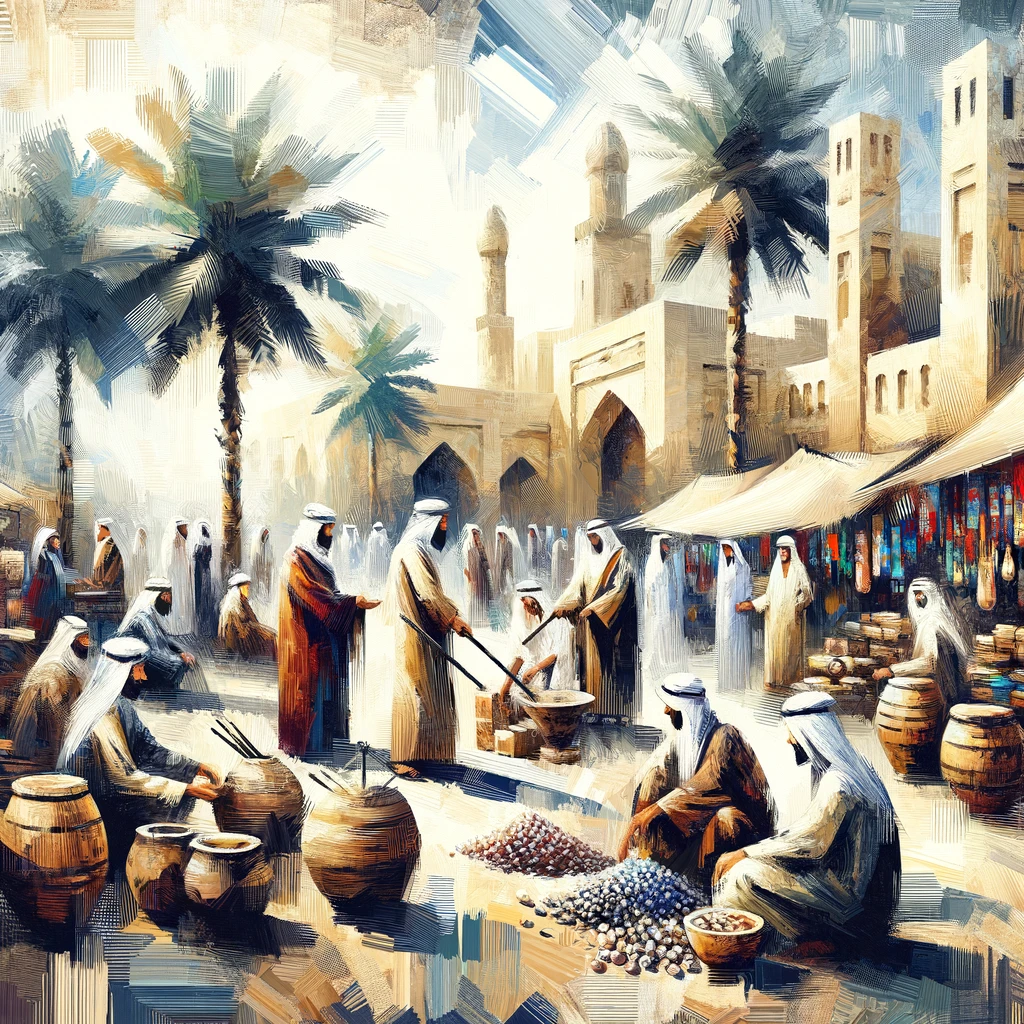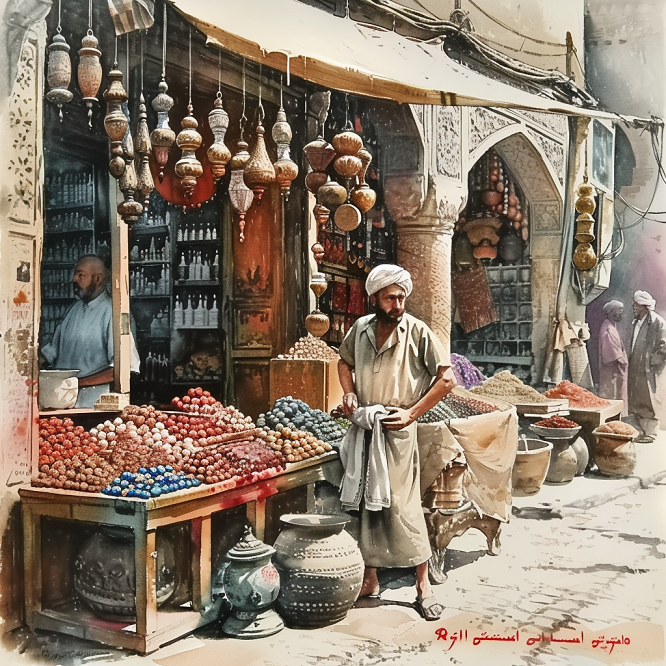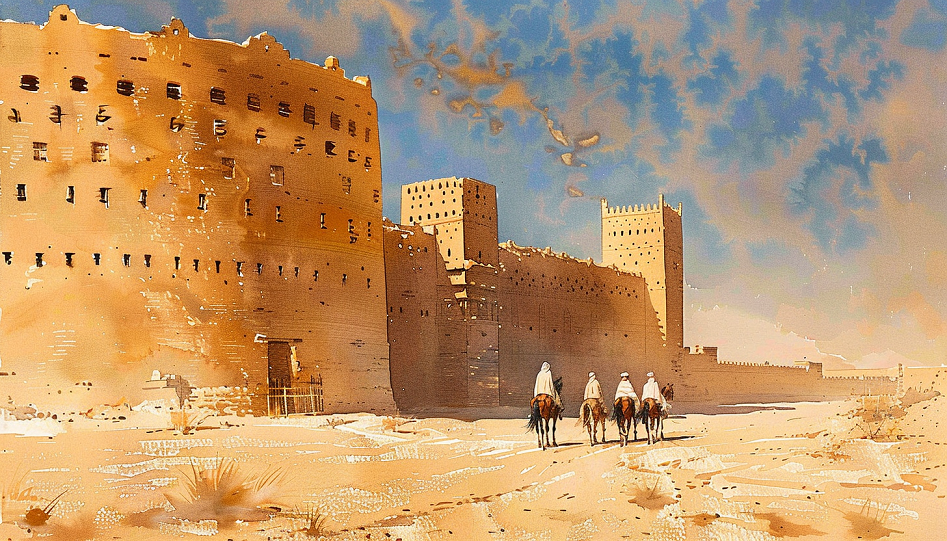Lady Anne Blunt, a prominent writer and traveler, provides a fascinating glimpse into the Arabian landscape and society in her book, “Pilgrimage to Nejd”. Through her detailed narrative and exploration of themes such as governance and power dynamics, society and economy, Blunt offers a unique perspective on the region that is both informative and insightful.
In her extensive collection of works, Lady Anne Blunt’s books provide a deep understanding of different cultures and societies, shedding light on the complexities and dynamics that shape their existence.
The Landscape and Constitution of Arabia
In “Pilgrimage to Nejd,” Lady Anne Blunt details a land that at first glance, appears barren and inhospitable. She describes Arabia, particularly the region of Nejd, as a rainless and waterless expanse where cultivation and regular human habitation seem almost impossible without reliance on well irrigation. Despite their austere surroundings, the regions’ inhabitants remarkably adapt to these demanding conditions, crafting an existence out of the thorny wilderness.
Blunt discusses the political constitution of Jebel Shammar, an aspect as unique and interesting as its geographical features. The indigenous population, heavily influenced by their climate and its challenges, implemented a form of government deeply rooted in their cultural values and environmental realities. This system reflects an innate resilience, carving out structure and order in an unyielding environment.
Blunt draws attention to the similarities and differences between the government operating in Jebel Shammar, specifically those of Ibn Rashid and the ancient Kings of Arabia. The comparison is an intriguing mixture of contrasts and commonalities, driven by the same overarching imperative of utilizing scarce resources appropriately for survival and prosperity.
The political constitution of Jebel Shammar is exceedingly curious ; not only is it unlike anything we are accustomed to in Europe, but it is probably unique, even in Asia. It would seem, in fact, to represent some ancient form of government indigenous to the country, and to have sprung naturally from the physical necessities of the land, and the character of its inhabitants. I look upon Ibn Rashid’s government as in all likelihood identical with that of the Kings of Arabia, who came to visit Solomon, and of the Shepherd Kings who, at a still earlier date, held Egypt and Babylonia ; and I have little doubt that it owes its success to the fact of its being thus in harmony with Arab ideas and Arab tradition.
Pilgrimage To Nejd: Lady Anne Blunt
She also explains the intriguing phenomenon of towns and villages congregating around sufficient water supplies, a natural occurrence influenced by the necessity of survival. This geographical reality influences their political makeup and asserts a unique form of individuality onto the settlements. Networks of these water-centric communities have formed the backbone of Arabian civilizations for centuries. They have defined their political boundaries as well as their social structure, carving out an idiosyncratic order amidst an unforgiving landscape.

Governance and Power Dynamics of Arabia
Lady Anne Blunt delves deeper into the societal structures and power dynamics that govern Arabia’s landscapes. Unraveling the complex web of relationships between towns and the Bedouin tribes, Blunt explicates the intricate dynamics underpinning their mutual survival in the arid expanses of Arabia. While towns provide the Bedouin tribes with markets for their camels, sheep, and wool goods, the latter extend their protection to these settlements, preserving them from potential raiders and rivals.
Consequent to their role as protectors, and further facilitated by the receipt of substantial tributes from the townspeople, the Bedouin Sheykh often transitioned from a guardian to a ruler. This transformation ensured the construction of castles that provided further security, culminating in the establishment of an effective albeit unlikely system of governance. It is a method that encapsulates a rare balance of power, as Blunt poignantly observes, a blend of authority, mutual respect, and reliance that flourishes in the unforgiving Nejd landscapes.
Blunt elucidates the political structure of Arabia, describing how the power dynamics are a recurrence of a longstanding order. This structure incorporates the Sheykh, or ‘prince’, as the head, followed by a number of officials with specific duties. Payments occur largely in nature, livestock or crops, forming a simple but effective system that sustains itself primarily on local resources. This investment into local resources and reliance on local capabilities subsequently reinforces the importance of sustainable governance within the realms of Nejd’s harsh realities.
The towns put themselves each under the protection of the principal Bedouin Sheykh of its district, who, on the consideration of a yearly tribute, guarantees the citizens’ safety outside the city walls, enabling them to travel unmolested as far as his jurisdiction extends, and this, in the case of a powerful tribe, may be many hundred miles, and embrace many cities.
Pilgrimage To Nejd: Lady Anne Blunt
One striking pattern discussed by Blunt is the recurrent emergence of this form of government in Arabia, particularly when it gains independence from foreign or domestic tyrants. This cycle serves as a testament to the resilience and adaptability of the Arabian people, embodying their capacity to preserve their autonomy amidst external influences and pressures. The adoption of this venerable political structure ensures the protection, subsistence, and prosperity of the Arabian civilization, securing them in the harsh climes they inhabit and master with remarkable prowess, as showcased in Lady Anne Blunt’s gripping narrative of the governance and power dynamics of Arabia.
The Rule of the Wahhabi Emir and the Ibn Rashid Dynasty
Lady Anne Blunt introduces readers to the rule of the Wahhabi Emir of Aared in an intriguing comparison to the reign of the first Caliphs. The Wahhabi Emir’s rule, as Blunt details, establishes a theocratic government where state and religion are intricately intertwined. Guided by the fundamental tenets of Islam, these Empires echo the reigns of the first Caliphs, where the spiritual sanctity gets preserved even as territorial domains expand.
The Ibn Saouds, “Imams of Nejd,” governed neither more nor less than had the first Caliphs, and with the same divine pretensions. But their rule came to an end in 1818, when Nejd was conquered by the Turks, and the reigning Ibn Saoud made prisoner and beheaded at Constantinople. Then, on the retirement of the Turks, (for they were unable long to retain their conquest,) shepherd government again asserted itself, and the principality of Jebel Sham mar was founded.
Pilgrimage To Nejd: Lady Anne Blunt
Concurrently, Blunt explores the establishment of the Ibn Rashid dynasty in Hail. Unlike the religiously motivated governance of the Wahhabi Emirs, the Ibn Rashid rulers stood firmly on the pillars of nationalist ideas. Their approach towards finance and decision-making was motivated by a residence-first orientation, which sought prosperity and progress for Hail and its people above all else.
The leadership of the Ibn Rashid dynasty, in particular, the notable figures of Abdallah and Mohammed Ibn Rashid, are thoroughly examined by Blunt. She emphasizes on their strategic vision and deft management of power – an amalgamation of traits that makes them locally revered figures. Their rule is characterized by their ability to navigate the complex tribal dynamics of the region while preserving the dignity of their subjects, maximizing resources and upholding the cultural and traditional values of Nejd.
The Shammar tribe is the most powerful of Northern Nejd, and the towns of Hall, Kefar, Bekaa, and the rest, put themselves under the protection of Abdallah ibn Rashid, who had suc- ceeded in gaining the Shammar Sheykhat for himself. He seems to have been a man of great ability, and to him is due the policy of rule which his descendants have ever since pursued. He took up his residence in Hail, and built the castle there, and caused himself to be recognized as Emir, first in vassalage to the Ibn Saouds, who had reappeared in Aared, but later on his own account.
Pilgrimage To Nejd: Lady Anne Blunt
Blunt also discusses the succession within the Sheykhat, examining the uncertainty that often led to internal conflicts and disputes. The structure of succession within Sheykhat, unlike the orderly systems found in western monarchies, is fluid and contested. It’s characterized by rivalries and intrigues that have shaped the political and social landscape of the region. Notable is the interest in maintaining a strong position within the influential tribal networks, as well as the establishment of an effective administration to govern the territory.
The rule of the Wahhabi Emir and the Ibn Rashid dynasty, as observed by Lady Anne Blunt, present a vivid portrayal of contrast in Arabia’s realms of power. Their governance, each unique in its motivations and approach, holds up a mirror to the varied and nuanced forms of political leadership that can exist, even within territories marked by scarcity, adversity, and a harsh natural environment. Theirs is a testament to the compelling interplay of religion, nationalism, tribalism, and power as guiding forces behind political rule in Arabia.

Society and Economy of Arabia
Lady Anne Blunt introduces readers to the vibrant society and complex economy of Nejd, the heartland of Arabia. By taking her readers on a journey through daily live and economic activities, Blunt adds a new layer of understanding to the region’s unique character and allure.
Living under the arduous conditions of the Nejd desert has instilled a sense of discipline, peace and temperance among the inhabitants. The harsh desert experience, as portrayed by Blunt, has shaped the nature of the people of Nejd into a model of resilience and adaptability. Despite the harsh environmental conditions, she observes societies characterized by harmony, self-reliance and adherence to moral and cultural norms. The virtue of hospitality is held in high regard, and disputes are typically resolved through traditional arbitration, thereby maintaining peace among the culturally diverse tribes of the region.
Alongside her impression of the society, Blunt presents the economic condition of Jebel Shammar, the mountainous region of Nejd, with precision and specificity. The economy of Jebel Shammar is primarily maintained through tributes and taxes which are often paid in kind. A large portion of these tributes is provided by townspeople in return for protection from the Sheikh, following an age-old tradition hinged on mutual benefit and sustenance. The economy’s viability rests on understanding and effectively utilizing local resources, resulting in an economic order that’s fundamentally local in nature.
The Arabs of Nejd are a singularly temperate race, and hardly ever indulge in brawling or breaches of the peace. If disputes arise between citizens they are almost always settled on the spot by the interference of neighbours; and the rowdyism and violence of European towns are unknown at Hail. Where, however, quarrels are not to be settled by the intervention of friends, the disputants bring their cases to the Emir, who settles them in open court, the mejlis, and whose word is final. The law of the Koran, though often referred to, is not, I fancy, the main rule of the Emir’s decision, but rather Ai-abian custom, an authority far older than the Mussulman code.
Pilgrimage To Nejd: Lady Anne Blunt
In a striking note, despite the austere environment and scarcity of resources, Blunt divulges that there is a significant share of the Emir’s revenue that is allocated towards entertainment and hospitality. This spending underscores the cultural importance of hospitality, contributing to the complex web of societal norms that are as much about assertion of power and prestige as they are about kinship and community.
From viewing the society and economy of Arabia through Lady Anne Blunt’s discerning lens, it becomes clear how these elements form a key part of the identity of the people of Nejd. The threads of economy are woven through the tapestry of society, with every aspect of life influenced and shaped by the harsh environment, ultimately contributing to the formation of a distinct culture that thrives in the heart of the desert.

Survival and Effectiveness of The Arabian Political System
In her detailed exploration of the Arabian social and political landscape, Lady Anne Blunt evaluates the survival capabilities and effectiveness of the system in power. Blunt’s analysis encapsulates months of close observation and in-depth understanding of the region, insightfully expressing her thoughts on the political system’s methodology and efficiency.
Notable in her discussion is the premise of the system’s stability and longevity over hundreds of years. Specifically, she expounds on Nejd’s reversion to an independent unit, similar to the model that existed since the second century of the Islamic era. This resilience in reverting back to a time-tested structure demonstrates the system’s adaptability and endurance, along with the people’s inherent preference for self-sustained and inceptive forms of government.
Blunt takes time to reflect on the foundational principles and policies that contribute to the rulers’ enduring appeal and popularity. She examines how leaders like Abdallah captivate public support without contradicting or violating the ancient unwritten law of Arabia. This unwritten law, revered as sacred social compact, forms the basis for the leaders’ acceptance, respect and authority amongst their subjects. It is a delicate balance between maintaining custom and tradition on one hand, and encouraging progress and development on the other.
Ibn Rashid, on the other hand, by the mere effect of his will, keeps all the desert in an absolute peace. In the whole district of Jebel Shammar, embracing, as it does, some of the wildest deserts, inhabited by some of the wildest people in the world, a traveller may go unarmed and unescorted, without more let or hindrance than if he were following a highway in England. On every road of Jebel Shammar, townsmen may be found jogging on donkey-back, alone, or on foot, carrying neither gun nor lance, and with all their wealth about them. If you ask about the dangers of the road, they will return the question, ” Are we not here in Ibn Rashid’s country ?
Pilgrimage To Nejd: Lady Anne Blunt
Lady Anne Blunt recognizes the ambition of leaders like Mohammed ibn Rashid who aims for dominion over the entire north of Arabia. Their ascendance to power and strategic vision lies not just in their military prowess or political acumen, but also their sensitivity to the rich tapestry of Arabian culture, tradition and its age-old societal norms. Capturing this ambition, Blunt notes that it is a delicate dance of steady progress framed within a firm embrace of the region’s past.
Lady Anne Blunt’s comprehensive commentary on the survival and effectiveness of this system offers a rich understanding of the mechanics underpinning the Society and economy of Arabia. This understanding ultimately reflects the region’s adaptability and the tenacity of its people in maintaining a resilient social and political structure amidst a challenging environment.
Conclusion
Lady Anne Blunt, in her enlightening narrative “Pilgrimage to Nejd,” draws a compelling conclusion regarding the flourishing financial state of Jebel Shammar under its current governance system. The effectiveness and suitability of this unique system of governance, rooted in the empowerment of the Bedouin tribes, stand as a testament to the resilience and adaptability of the Arabian people.
Through her meticulous observations and detailed analysis, Blunt underscores the necessity of a delicate balance between the desert and the town for peace to prevail in Arabia. The symbiotic relationship between the harsh environment and human habitation, intricately woven into the social and economic fabric of the region, underscores the importance of mutual respect and cooperation for survival in a challenging landscape.

